【Cancer Cell】2025年6-7月刊论文导读
期刊介绍:
Cancer Cell创刊于2002年,由CELL PRESS出版商出版,收稿方向涵盖医学-肿瘤学全领域,在行业领域中学术影响力很大,属于TOP期刊,国际一流期刊。审议手稿的主要标准是研究是否在回答与自然发生的癌症有关的重要问题方面取得重大进展。影响因子指数48.8。

Jun 09, 2025 Volume 43Issue 6p993-1180
2025年6月,Cancer Cell共发表15篇文章,其中包括Commentary 1篇,Previews 4篇,Articles 10篇。
1.A niche driven mechanism determines response and a mutation-independent therapeutic approach for myeloid malignancies
髓系恶性肿瘤的治疗响应由微环境驱动机制决定,并存在一种不依赖突变的治疗方法

哥伦比亚大学医学中心内科和外科医学院生理和细胞生物物理系等机构联合发表
Summary
Myeloid cancers such as myelodysplastic syndromes (MDS) and acute myeloid leukemia (AML) remain resistant to standard of care (SOC) and targeted therapies. In this study, we demonstrate that responsiveness to therapy is associated with activation of β-catenin-JAG1 in osteoblastic cells of patients treated with all-trans-retinoic acid (ATRA). ATRA suppresses β-catenin activity in patients and leukemic mice. Consequently, it inhibits the growth and survival of MDS/AML cells from patients with active β-catenin-JAG1 signaling and promotes their differentiation. This occurs independently of cytogenetics and mutational profile. ATRA also improves disease outcome in mice with no evidence of relapse and a superior safety profile to SOC. A human anti-JAG1 antibody improves efficacy in leukemic mice and patient-derived MDS/AML cells. β-catenin activation provides an explanation for the differential response to ATRA and a mechanistic biomarker for ATRA repurposing in myeloid malignancies, potentially evading relapse and extending across a broad range of cancers.
髓系恶性肿瘤,如骨髓增生异常综合征 (MDS) 和急性髓系白血病 (AML),对标准治疗 (SOC) 和靶向疗法仍存在耐药性。本研究发现,接受全反式维甲酸 (ATRA) 治疗的患者,其治疗反应性与成骨细胞中β-连环蛋白(β-catenin)-JAG1信号通路的激活状态相关。ATRA能抑制患者和白血病小鼠模型中β-catenin的活性。因此,它能够抑制来自具有活化β-连环蛋白-JAG1信号通路患者的MDS/AML细胞的生长和存活,并促进其分化。这一效应独立于细胞遗传学异常和突变谱,还能改善小鼠的疾病结局,且无复发迹象,其安全性优于标准治疗。一种人源化抗 JAG1 抗体可增强对白血病小鼠和患者来源的 MDS/AML 细胞的疗效。β-连环蛋白的激活为 ATRA 的差异化治疗反应的解释提供了依据,还可作为ATRA在髓系恶性肿瘤中老药新用的机制性生物标志物。总之,该疗法有望避免疾病复发,并具备广泛应用于多种癌症的潜力。
2.Spatial transcriptomics reveals tryptophan metabolism restricting maturation of intratumoral tertiary lymphoid structures
空间转录组学揭示色氨酸代谢限制肿瘤内三级淋巴结构成熟
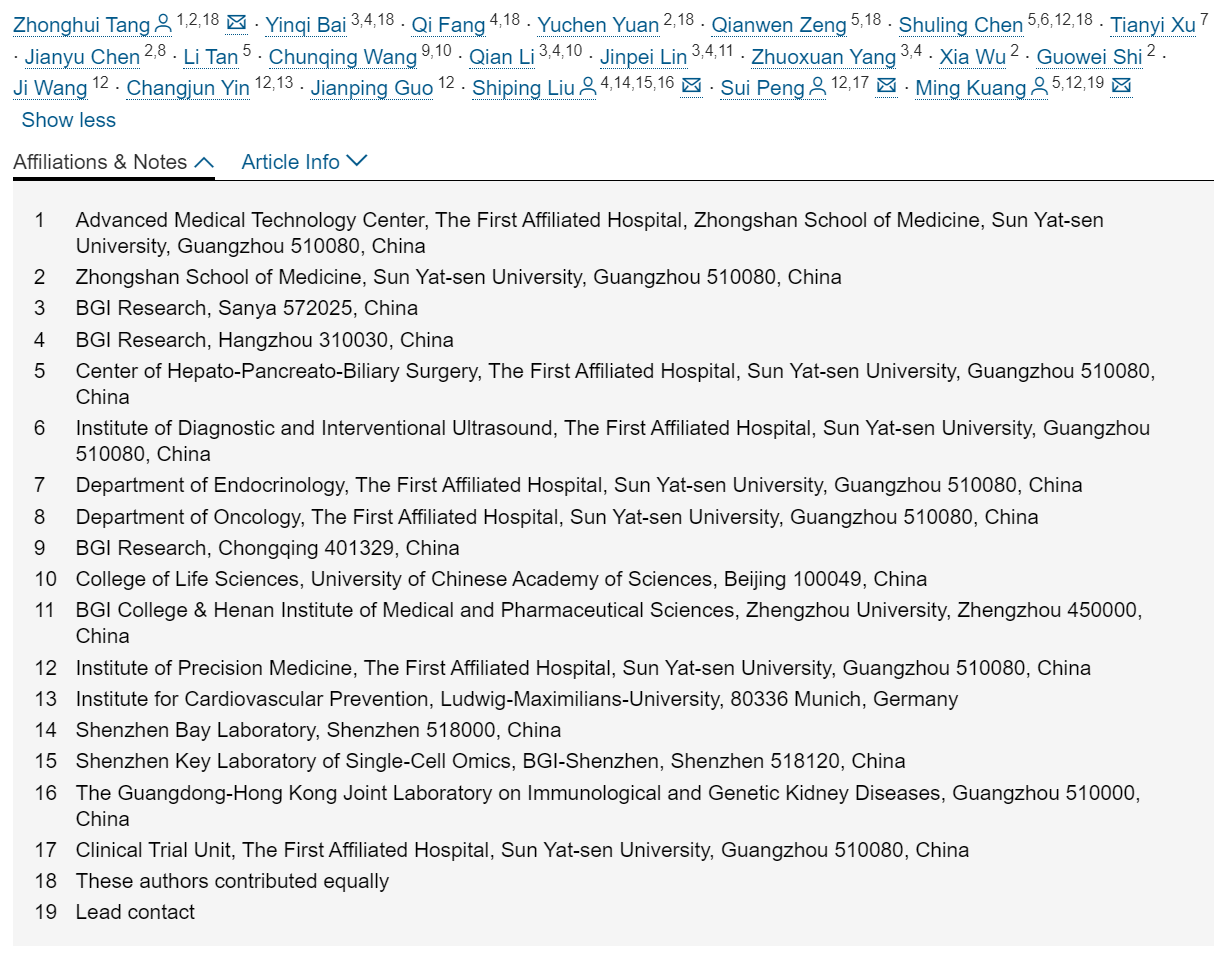
中山大学中山医学院附属第一医院等机构联合发表
Summary
Tertiary lymphoid structures (TLSs) are ectopic lymphoid aggregates found in numerous cancers, often linked to enhanced immunotherapy responses and better clinical outcomes. However, the factors driving TLS maturation are not fully understood. Using near single-cell spatial transcriptomic mapping, we comprehensively profile TLSs under various maturation stages and their microenvironment in hepatocellular carcinoma (HCC). Based on their developmental trajectories, we classify immature TLSs into two groups: conforming and deviating TLSs. Our findings indicate that conforming TLSs, similar to mature TLSs, possess a niche function for immunotherapy responses, while deviating TLSs do not. We discover that the tryptophan-enriched metabolic microenvironment shaped by malignant cells contributes to the deviation of TLS maturation. Inhibiting tryptophan metabolism promotes intratumoral TLS maturation and enhances tumor control, synergizing with anti-PD-1 treatments. Therefore, promoting TLS maturation represents a potential strategy to improve antitumor responses and immunotherapy outcomes.
三级淋巴结构(TLSs)是在多种癌症中发现的异位淋巴聚集体,其存在通常与增强的免疫治疗反应和更好的临床预后相关。然而,驱动TLS成熟的机制尚未完全阐明。本研究利用接近单细胞水平的高精度空间转录组图谱技术,全面解析了肝细胞癌(HCC)中不同成熟阶段的TLS及其微环境特征。基于发育轨迹分析,该研究将未成熟TLS分为两类:趋同型TLS和偏离型TLS。研究结果表明,趋同型TLS与成熟TLS类似的微环境功能,能够促进免疫治疗应答,而偏离型TLS则不具备此功能。进一步机制研究表明,由肿瘤细胞塑造的、富含色氨酸的代谢微环境是导致TLS成熟偏离的关键原因。抑制色氨酸代谢可促进瘤内TLS成熟并增强肿瘤控制效果,且与抗PD-1治疗具有协同增效作用。因此,促进TLS成熟有望成为增强抗肿瘤免疫反应和提高免疫治疗疗效的一种潜在策略。
3.Cancer cell-derived arginine fuels polyamine biosynthesis in tumor-associated macrophages to promote immune evasion
癌细胞来源的精氨酸驱动肿瘤相关巨噬细胞中的多胺生物合成以促进免疫逃逸
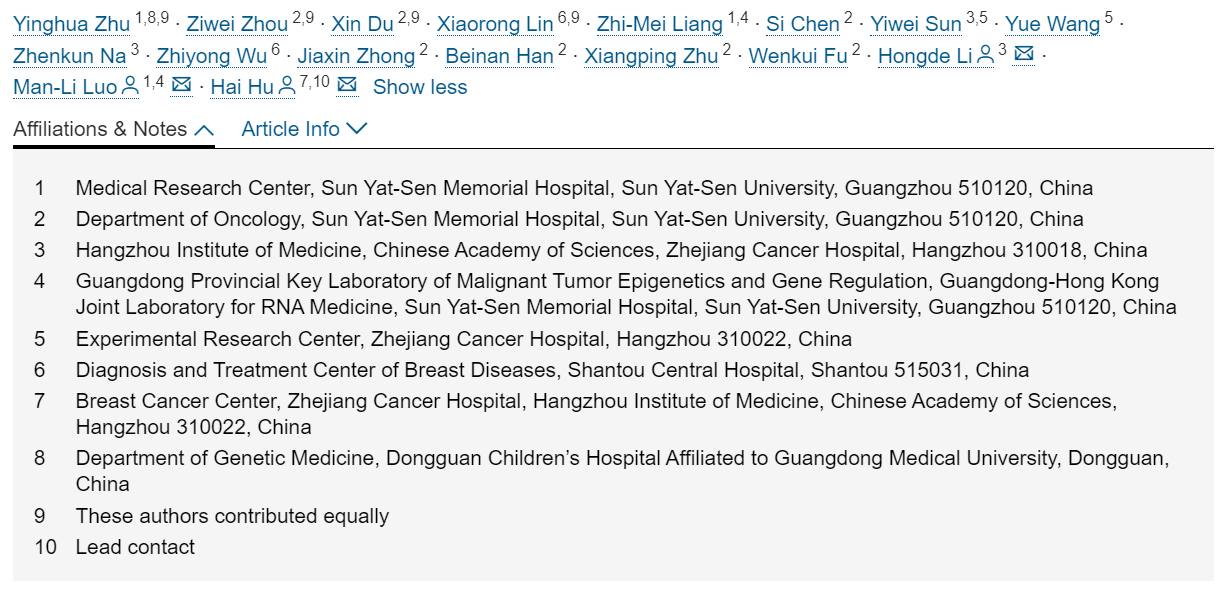
中山大学中山纪念医院医学研究中心等机构联合发表
Summary
Arginine metabolism reshapes the tumor microenvironment (TME) into a pro-tumor niche through complex metabolic cross-feeding among various cell types. However, the key intercellular metabolic communication that mediates the collective effects of arginine metabolism within the TME remains unclear. Here, we reveal that the metabolic interplay between cancer cells and macrophages plays a dominant role in arginine-driven breast cancer progression. Within the TME, breast cancer cells serve as the primary source of arginine, which induces a pro-tumor polarization of tumor-associated macrophages (TAMs), thereby suppressing the anti-tumor activity of CD8+ T cells. Notably, this cancer cell-macrophage interaction overrides the arginine-mediated enhancement of CD8+ T cell anti-tumor activity. Mechanistically, polyamines derived from arginine metabolism enhance pro-tumor TAM polarization via thymine DNA glycosylase (TDG)-mediated DNA demethylation, regulated by p53 signaling. Importantly, targeting the arginine-polyamine-TDG axis between cancer cells and macrophages significantly suppresses breast cancer growth, highlighting its therapeutic potential.
精氨酸代谢通过肿瘤微环境(TME)中多种细胞类型间复杂的代谢互作,将TME重塑为促肿瘤生长的生态位。然而,介导精氨酸代谢在TME内协同效应的关键细胞间代谢通讯机制仍不明确。本研究发现,癌细胞与巨噬细胞之间的代谢互作在精氨酸驱动的乳腺癌进展中发挥着主导作用。在TME内,乳腺癌细胞作为精氨酸的主要来源,可诱导肿瘤相关巨噬细胞(TAMs)发生促肿瘤极化,从而抑制CD8+ T细胞的抗肿瘤活性。值得注意的是,这种癌细胞-巨噬细胞间的互作超越了精氨酸本身介导的CD8+ T细胞抗肿瘤活性增强作用。从机制上讲,精氨酸代谢衍生的多胺通过胸腺嘧啶DNA糖基化酶(TDG)介导的DNA去甲基化促进促肿瘤TAM的极化,该过程受到p53信号通路的调控。重要的是,靶向癌细胞与巨噬细胞之间的精氨酸-多胺-TDG轴能显著抑制乳腺癌生长,表明该途径具有重要的治疗潜力。
4.Spatial determinants of antibody-drug conjugate SHR-A1811 efficacy in neoadjuvant treatment for HER2-positive breast cancer
抗体偶联药物SHR-A1811在HER2阳性乳腺癌新辅助治疗中疗效的空间决定因素

复旦大学上海肿瘤中心乳腺外科,上海市乳腺癌重点实验室等机构联合发表
Summary
Selecting optimal candidates for next-generation anti-human epidermal growth factor receptor 2 (HER2) antibody-drug conjugates (ADCs) remains challenging. We conduct a prespecified translational study to identify treatment biomarkers in SHR-A1811-treated HER2-positive breast cancer patients from the phase 2 neoadjuvant FASCINATE-N trial using DNA and RNA sequencing, computational pathology, and single-cell in situ spatial imaging. In the hormone receptor (HR)-negative subgroup, a higher proportion and more infiltration of immune cells (i.e., tumor-infiltrating lymphocytes [TILs]), particularly cytotoxic T cells, are associated with better treatment responses. In the HR-positive subgroup, the closeness and aggregation of HER2-strong-positive tumor cells, as opposed to a uniform distribution, are linked to a lower response rate and HER2 luminal-like (HER2-LUM) subtype, which more closely resembles HR+/HER2− breast cancer. In addition, we develop a clinically practical predictive model capable of predicting neoadjuvant treatment responses to SHR-A1811 and other novel ADCs based on clinicopathological characteristics and pathological images.
目前,为新一代抗人表皮生长因子受体2(HER2)抗体偶联药物(ADCs)筛选最佳适用人群仍具挑战性。该研究开展了一项转化研究,基于II期新辅助临床试验FASCINATE-N的数据,利用DNA/RNA测序、计算病理学和单细胞原位空间成像技术,旨在鉴定接受SHR-A1811治疗的HER2阳性乳腺癌患者的治疗生物标志物。研究结果显示,在激素受体(HR)阴性亚组中,有更高比例的免疫细胞浸润(即肿瘤浸润淋巴细胞,TILs),尤其是细胞毒性T细胞,与更好的治疗反应相关。而在HR阳性亚组中,HER2强阳性肿瘤细胞的聚集(而非均匀分布)与较低的治疗反应率相关,并多见于HER2管腔样(HER2-LUM)亚型,该亚型更接近于HR+/HER2-乳腺癌。此外,研究开发了一种临床实用的预测模型,该模型能够基于临床病理特征与病理图像,预测患者对SHR-A1811及其他新型ADCs的新辅助治疗反应。
5.Radiotherapy promotes cuproptosis and synergizes with cuproptosis inducers to overcome tumor radioresistance
放疗促进铜死亡并与铜死亡诱导剂协同克服肿瘤放疗抵抗
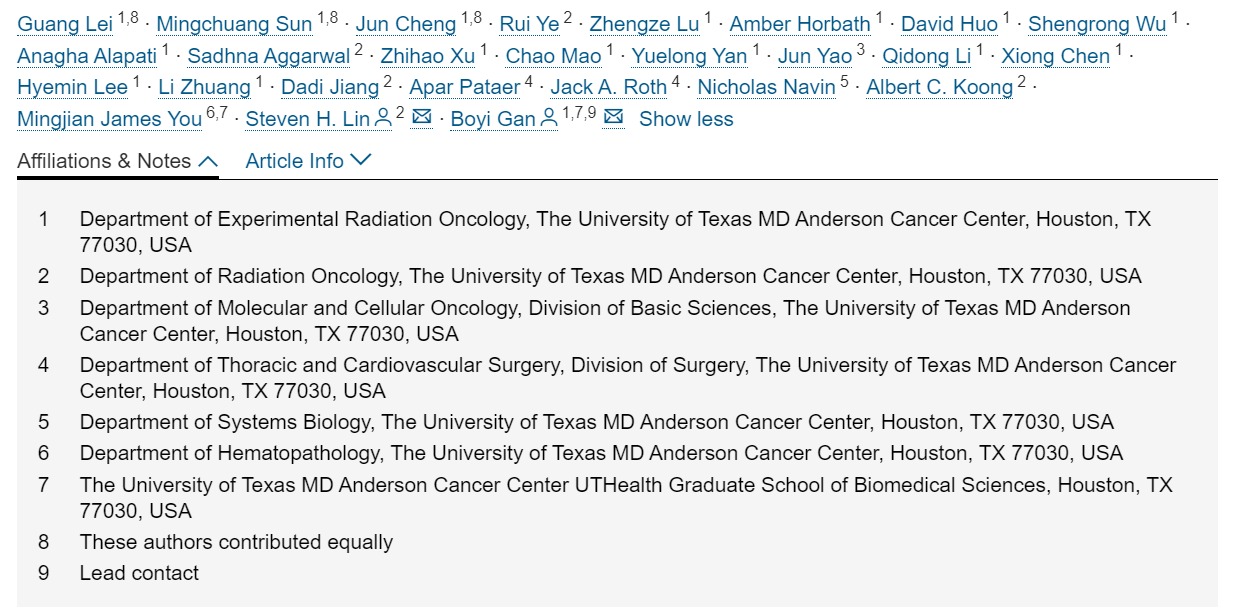
德克萨斯大学MD安德森癌症中心实验放射肿瘤科等机构联合发表
Summary
Cuproptosis is a recently identified form of copper-dependent cell death. Here, we reveal that radiotherapy (RT) induces cuproptosis in cancer cells, independent of apoptosis and ferroptosis, and depletes lipoylated proteins and iron-sulfur (Fe-S) cluster proteins—both hallmarks of cuproptosis—in patient tumors. Mechanistically, RT elevates mitochondrial copper levels by upregulating copper transporter 1 (CTR1) and depleting mitochondrial glutathione, a copper chelator, thereby triggering cuproptosis. Integrated analyses of RNA sequencing (RNA-seq) from radioresistant esophageal cancer cells and single-cell RNA-seq from esophageal tumors of patients unresponsive to RT link radioresistance to the downregulation of BTB and CNC homology 1 (BACH1). This downregulation de-represses the expression of copper-sequestering metallothionein (MT) 1E/X, thereby mitigating cuproptosis and contributing to radioresistance. Copper ionophore treatment sensitizes radioresistant cancer cells and cell line- and patient-derived xenografts to RT by potentiating cuproptosis. Our findings unveil a link between RT and cuproptosis and inform a therapeutic strategy to overcome tumor radioresistance by targeting cuproptosis.
铜死亡(Cuproptosis)是最近发现的一种铜依赖性细胞死亡形式。本研究发现,放疗可诱导癌细胞发生铜死亡,该过程独立于凋亡和铁死亡。在患者肿瘤中,放疗同时耗竭脂酰化蛋白和铁硫(Fe-S)簇蛋白,两者均为铜死亡的标志物。机制上,放疗通过上调铜转运蛋白1(CTR1)并耗竭线粒体谷胱甘肽(一种铜螯合剂),从而升高线粒体内的铜水平,最终触发铜死亡。通过对放疗抵抗的食管癌细胞进行的RNA测序(RNA-seq)以及对放疗无反应的食管癌患者肿瘤的单细胞RNA测序(scRNA-seq)综合分析,研究表明,放疗抵抗与BACH1(BTB和CNC同源蛋白1)的下调相关。BACH1的下调解除了其对螯合铜的金属硫蛋白(MT)1E/X表达的抑制,从而减轻铜死亡并导致放疗抵抗。使用铜离子载体治疗可通过增强铜死亡,提高放疗抵抗的癌细胞、细胞系来源的异种移植瘤和患者来源的异种移植瘤对放疗的敏感性。该研究结果揭示了放疗与铜死亡之间的联系,并为通过靶向铜死亡克服肿瘤放疗抵抗提供了一种治疗策略依据。
6.Bone metastases diminish extraosseous response to checkpoint blockade immunotherapy through osteopontin-producing osteoclasts
骨转移通过破骨细胞源性骨桥蛋白介导系统性免疫抑制,削弱检查点阻断疗法对骨外肿瘤的疗效
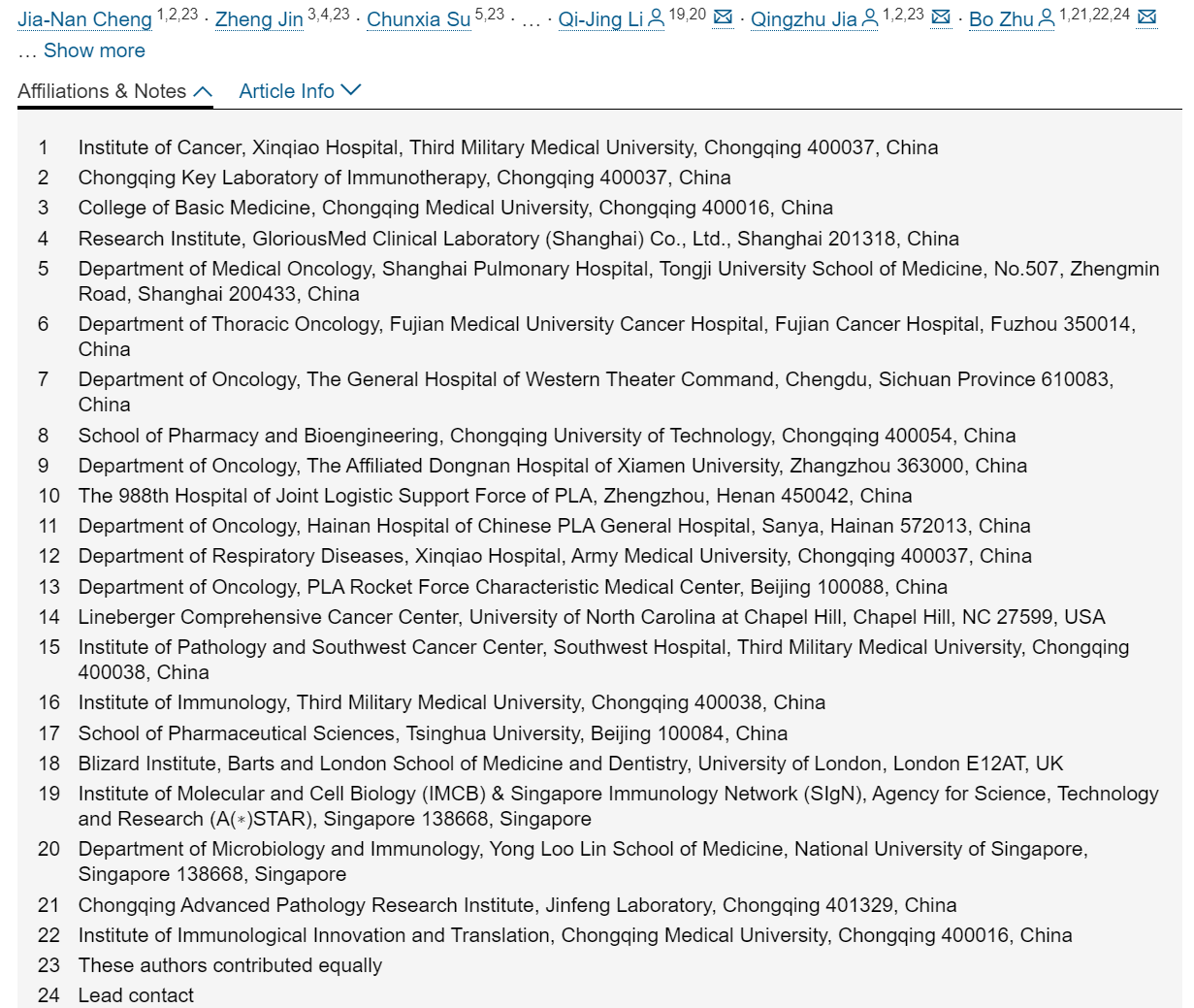
第三军医大学新桥医院肿瘤研究所等机构联合发表
Summary
Bone metastatic lesions typically associate with suboptimal responses to immune checkpoint blockade (ICB) therapies. In this study, we observed that across multiple clinical cohorts and a variety of mouse models, the presence of osseous metastases induces ICB resistance in extraosseous tumors. Mechanistically, this long-distance communication is mediated by osseous tumor-conditioned osteoclasts producing osteopontin (OPN). Through circulation, OPN reprograms the extraosseous tumor microenvironment and impairs T cell recruitment and differentiation of CD8+TCF1+ precursor cells, an essential population for ICB efficacy. In mice, ICB responsiveness is restored by αRANKL blockade of osteoclastogenesis, neutralization of OPN in circulation, or tissue-specific depletion of OPN in osteoclasts. Both the mode of action and therapeutic benefit were validated in clinical cohorts with the αRANKL-ICB combinatory regimen. These findings establish bone as a specific immunoregulatory organ exploited by tumor metastasis and suggest osteoclastogenesis as a promising target to improve ICB prognosis in patients with bone metastasis.
骨转移瘤通常对免疫检查点阻断(ICB)疗法反应不佳。 本研究发现,在多个临床队列和多种小鼠模型中,骨转移灶的存在会诱导骨外肿瘤产生ICB耐药性。其机制在于:骨转移灶中的肿瘤细胞会“驯化”破骨细胞,使其分泌骨桥蛋白(OPN)。OPN通过血液循环作用于远端骨外肿瘤,重塑肿瘤微环境,阻碍T细胞的募集,并抑制CD8+TCF1+前体细胞(这类细胞对ICB疗效至关重要)的分化。在小鼠模型中,以下方式可恢复肿瘤对ICB的治疗反应:使用αRANKL抗体阻断破骨细胞形成、中和循环中的OPN、或特异性清除破骨细胞内的OPN。上述作用机制及其治疗效果,在采用αRANKL抗体联合ICB方案的临床队列中已得到了验证。总之,该研究证实,骨骼是肿瘤转移利用的一个特定免疫调节器官,并提示靶向破骨细胞形成是改善骨转移患者ICB疗效的一个极具前景的策略。
7.Stromal lipid species dictate melanoma metastasis and tropism
基质脂质种类决定黑色素瘤的转移与器官趋向性
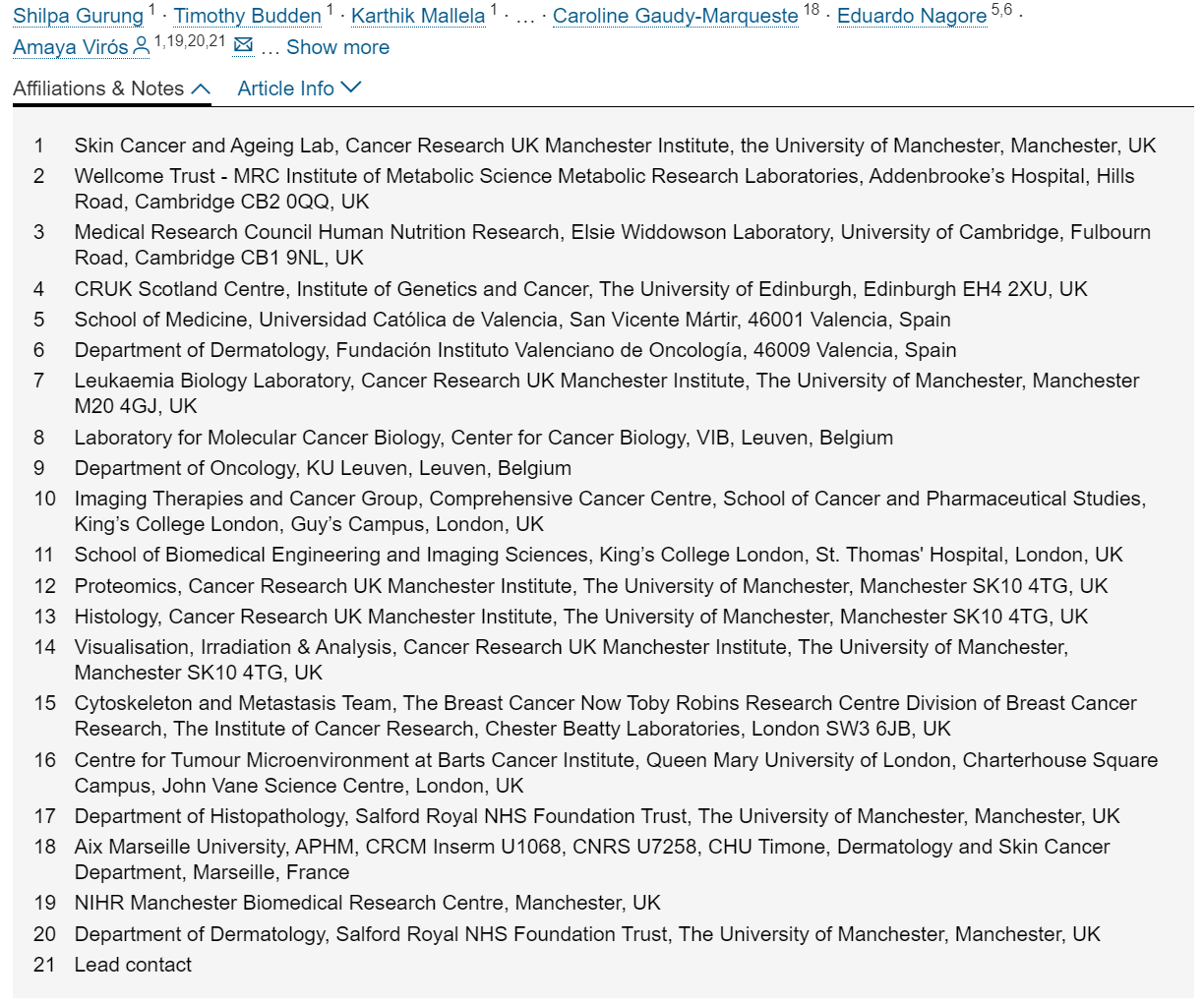
英国曼彻斯特大学曼彻斯特研究所皮肤癌和衰老实验室
Summary
Cancer cells adapt to signals in the tumor microenvironment (TME), but the TME cues that impact metastasis and tropism are still incompletely understood. We show that abundant stromal lipids from young subcutaneous adipocytes, including phosphatidylcholines, are taken up by melanoma cells, where they upregulate melanoma PI3K-AKT signaling, fatty acid oxidation, oxidative phosphorylation (OXPHOS) leading to oxidative stress, resulting in decreased metastatic burden. High OXPHOS melanoma cells predominantly seed the lung and brain; decreasing oxidative stress with antioxidants shifts tropism from the lung to the liver. By contrast, the aged TME provides fewer total lipids but is rich in ceramides, leading to lower OXPHOS and high metastatic burden. Aged TME ceramides taken up by melanoma cells activate the S1P-STAT3-IL-6 signaling axis and promote liver tropism. Inhibiting OXPHOS in the young TME or blocking the IL-6 receptor in the aged TME reduces the age-specific patterns of metastasis imposed by lipid availability.
癌细胞能够响应肿瘤微环境(TME)中的信号,但影响其转移和器官趋向性的具体TME因素尚未完全阐明。本研究发现,在年轻个体的TNE中,丰富的基质脂质(包括磷脂酰胆碱)可被黑色素瘤细胞摄取,继而激活PI3K-AKT信号通路,促进脂肪酸氧化和氧化磷酸化(OXPHOS)。高水平的OXPHOS导致氧化应激,最终降低了整体转移负荷。高OXPHOS水平的黑色素瘤细胞主要趋向转移至肺和脑组织。值得注意的是,使用抗氧化剂缓解氧化应激可改变其器官趋向性,使其从肺转向肝脏。相比之下,老年个体TME提供的总脂质较少,但富含神经酰胺,导致黑色素瘤细胞摄取这些神经酰胺后,OXPHOS水平降低,转移负荷增加。老年个体TME中的神经酰胺激活了黑色素瘤细胞内的S1P-STAT3-IL-6信号轴,从而促进了向肝脏转移的趋向性。关键干预研究表明:在年轻个体TME中抑制OXPHOS,或在老年TME中阻断IL-6受体,均能有效减轻由脂质可利用性决定的这种年龄特异性转移模式。
8.Spatial and multiomics analysis of human and mouse lung adenocarcinoma precursors reveals TIM-3 as a putative target for precancer interception
人类和小鼠肺腺癌癌前病变的空间与多组学分析揭示TIM-3作为癌前干预的潜在靶点

美国德克萨斯大学MD安德森癌症中心胸/头颈肿瘤内科
Summary
How tumor microenvironment shapes lung adenocarcinoma (LUAD) precancer evolution remains poorly understood. Spatial immune profiling of 114 human LUAD and LUAD precursors reveals a progressive increase of adaptive response and a relative decrease of innate immune response as LUAD precursors progress. The immune evasion features align the immune response patterns at various stages. TIM-3-high features are enriched in LUAD precancers, which decrease in later stages. Furthermore, single-cell RNA sequencing (scRNA-seq) and spatial immune and transcriptomics profiling of LUAD and LUAD precursor specimens from 5 mouse models validate high TIM-3 features in LUAD precancers. In vivo TIM-3 blockade at precancer stage, but not at advanced cancer stage, decreases tumor burden. Anti-TIM-3 treatment is associated with enhanced antigen presentation, T cell activation, and increased M1/M2 macrophage ratio. These results highlight the coordination of innate and adaptive immune response/evasion during LUAD precancer evolution and suggest TIM-3 as a potential target for LUAD precancer interception.
肿瘤微环境(TME)如何调控肺腺癌(LUAD)癌前病变的演化尚不明确。通过对114例人类LUAD及癌前病变样本进行空间免疫图谱分析,本研究发现,随着癌前病变进展,适应性免疫应答逐渐增强,而天然免疫应答相对减弱,且各阶段的免疫逃逸特征均与对应免疫应答模式相符。TIM-3高表达特征在LUAD癌前病变中显著富集,并随肿瘤进展逐渐降低。进一步,通过对5种小鼠模型的LUAD及癌前病变样本进行单细胞RNA测序(scRNA-seq)和空间免疫-转录组联合分析,验证了TIM-3在癌前病变中的持续高表达。关键体内干预实验表明,在癌前病变阶段(而非晚期肿瘤阶段)进行TIM-3阻断治疗可显著降低肿瘤负荷。其机制与增强抗原呈递、促进T细胞活化以及提高M1/M2巨噬细胞比例相关。这些结果揭示了LUAD癌前演化过程中天然免疫与适应性免疫应答/逃逸的协同调控机制,并提示TIM-3可作为LUAD癌前干预的潜在治疗靶点。
9.Genetic modeling of ELP1-associated Sonic hedgehog medulloblastoma identifies MDM2 as a selective therapeutic target
ELP1相关Sonic hedgehog髓母细胞瘤的遗传学模型鉴定MDM2为选择性治疗靶点

美国田纳西州孟菲斯市圣裘德儿童研究医院神经肿瘤学科学卓越中心
Summary
Germline loss-of-function (LOF) variants in Elongator acetyltransferase complex subunit 1 (ELP1) are the most prevalent predisposing genetic events in childhood medulloblastoma (MB), accounting for ∼30% of the Sonic hedgehog (SHH) 3 subtype. The mechanism(s) by which germline ELP1 deficiency provokes SHH-MB pathogenesis remain unknown. Genetically engineered mice mimicking heterozygous Elp1 LOF (Elp1HET) seen in affected germline carriers exhibit hallmark features of premalignancy in cerebellar granule neuron progenitors (GNPs), including increased DNA replication stress, genomic instability, accelerated cell cycle, and stalled differentiation. Orthotopic transplantation of Elp1HET GNPs harboring somatic Ptch1 inactivation yields SHH-MB-like tumors with compromised p53 signaling, providing a plausible explanation for the exclusivity of ELP1-associated MBs in the SHH-3 subtype. Preclinical treatment of ELP1-mutant patient-derived xenografts with an FDA-approved MDM2 inhibitor reactivates p53-dependent apoptosis and extends survival. Our findings functionally substantiate the role of ELP1 deficiency in SHH-MB predisposition and nominate therapeutics targeting MDM2 as a rational treatment option.
胚系功能缺失(LOF)变异是儿童髓母细胞瘤(MB)最常见的遗传易感因素,其中Elongator乙酰转移酶复合体亚基1(ELP1) 的LOF变异约占Sonic hedgehog(SHH)亚型SHH-3的30%。然而,胚系ELP1缺陷诱发SHH-MB的机制尚不明确。本研究构建了模拟患者杂合性ELP1缺失(Elp1HET) 的基因工程小鼠模型,发现其小脑颗粒神经元前体细胞(GNPs)呈现癌前病变特征,包括DNA复制应激增加、基因组不稳定性加剧、细胞周期加速及分化阻滞。将伴有体细胞Ptch1失活的Elp1HET GNPs原位移植后,可形成SHH-MB样肿瘤,并伴随p53信号通路受损,这为ELP1相关MB仅发生于SHH-3亚型(高发 TP53 突变)提供了合理的解释。临床前研究表明,采用FDA批准的MDM2抑制剂治疗ELP1突变患者来源移植瘤(PDX),可重新激活p53依赖性凋亡并延长生存期。本研究从功能层面证实ELP1缺陷在SHH-MB易感性中的作用,并提出靶向MDM2的治疗策略。
10.Isocitrate dehydrogenase 1 primes group-3 medulloblastomas for cuproptosis
异柠檬酸脱氢酶1(IDH1)调控DLAT表达介导Group 3髓母细胞瘤铜死亡敏感性

美国密歇根大学病理学系脑肿瘤代谢与表观遗传学实验室
Summary
MYC-driven group-3 medulloblastomas (MBs) are malignant pediatric brain cancers without cures. To define actionable metabolic dependencies, we identify upregulation of dihydrolipoyl transacetylase (DLAT), the E2-subunit of pyruvate dehydrogenase complex (PDC) in a subset of group-3 MB with poor prognosis. DLAT is induced by c-MYC and targeting DLAT lowers TCA cycle metabolism and glutathione synthesis. We also note upregulation of isocitrate dehydrogenase 1 (IDH1) gene expression in group-3 MB patient tumors and suppression of IDH1 epigenetically reduces c-MYC and downstream DLAT levels in multiple c-MYC amplified cancers. DLAT is a central regulator of cuproptosis (copper-dependent cell death) induced by the copper ionophore elesclomol. DLAT expression in group-3 MB cells correlates with increased sensitivity to cuproptosis. Elesclomol is brain-penetrant and suppresses tumor growth in vivo in multiple group-3 MB animal models. Our data uncover an IDH1/c-MYC dependent vulnerability that regulates DLAT levels and can be targeted to kill group-3 MB by cuproptosis.
MYC驱动的Group 3髓母细胞瘤(MB)是一类缺乏有效治疗手段的恶性儿童脑瘤。为探索其可干预的代谢依赖性,本研究发现,在预后不良的Group 3 MB亚群中,二氢硫辛酰胺转乙酰酶(DLAT)——丙酮酸脱氢酶复合体的E2亚基的表达显著上调。DLAT受c-MYC诱导,靶向抑制DLAT可降低三羧酸循环代谢与谷胱甘肽合成。研究进一步分析发现,Group 3 MB患者肿瘤中异柠檬酸脱氢酶1(IDH1)基因表达升高,表观遗传抑制IDH1能在多种c-MYC扩增型癌症中降低c-MYC及下游DLAT水平。DLAT作为铜死亡(铜依赖性细胞死亡)的核心调控因子,其表达水平与Group 3 MB细胞对铜离子载体Elesclomol的敏感性呈正相关。Elesclomol具有血脑屏障穿透能力,在多种Group 3 MB动物模型中均能抑制肿瘤生长。综上,本研究揭示了一条通过IDH1/c-MYC轴调控DLAT的代谢脆弱性通路,并提出可借助铜死亡机制靶向治疗Group 3 MB的潜在策略。

Jul 14, 2025 Volume 43Issue 7p1181-1384
2025年7月,Cancer Cell共发表15篇文章,其中包括Commentary 2篇,Previews 5篇,Articles 8篇。
1.ZEB2 is a master switch controlling the tumor-associated macrophage program
ZEB2作为调控肿瘤相关巨噬细胞程序的主开关
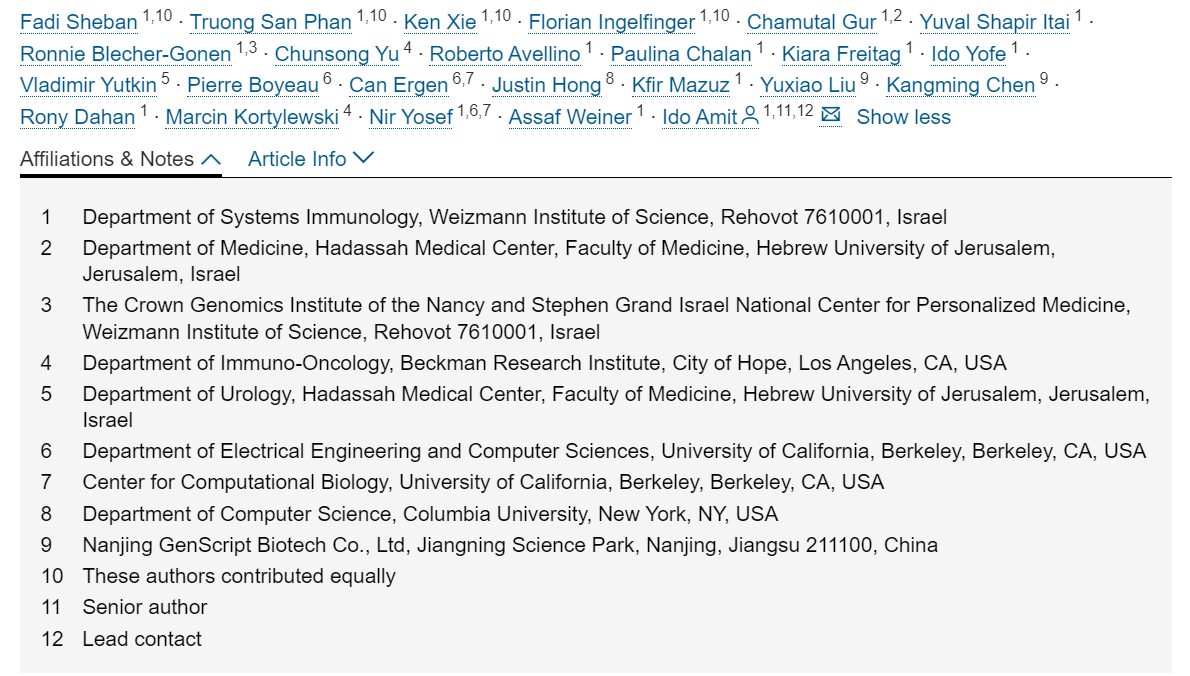
以色列魏茨曼科学研究所系统免疫学系
Summary
Tumor-associated macrophages (TAMs) are key mediators of tumor immune evasion. However, their regulatory circuits and checkpoints are partially understood. Here, we generated a TAM regulatory network by integrating human tumors single-cell RNA sequencing (scRNA-seq) data with a dedicated CRISPR screen. Using a deep generative model, we constructed a gene perturbation network linking individual candidates with prototypical TAM functions. We identified Zeb2 as the master regulator of TAM programs, orchestrating suppression of type-I interferon response and antigen presentation alongside activation of immune suppression programs. Genetic ablation of ZEB2 reprograms TAM function and identity on the chromatin, RNA, and protein levels. In macrophage-rich human tumors, ZEB2 expression is associated with poor prognosis. Selective Zeb2 in vivo targeting reprograms TAMs and mobilizes systemic T cell responses, achieving robust tumor clearance. Overall, our study generates a detailed roadmap of TAM gene circuits and identifies ZEB2 as a master switch with therapeutic potential.
肿瘤相关巨噬细胞(TAMs)是介导肿瘤免疫逃逸的关键细胞群体,但其调控网络与免疫检查点机制尚未完全阐明。本研究整合了人类肿瘤的单细胞RNA测序(scRNA-seq)数据与定制化CRISPR筛选结果,构建了TAM的调控网络;利用深度生成模型绘制出连接候选基因与典型TAM功能的基因扰动网络,并鉴定出ZEB2作为TAM程序的主调控因子。ZEB2通过协调抑制I型干扰素应答与抗原呈递功能,同时激活免疫抑制程序来实现调控。ZEB2基因敲除可在染色质、RNA及蛋白质水平上重塑TAM的功能与身份特征。在巨噬细胞富集的人类肿瘤中,ZEB2高表达与不良预后显著相关。体内选择性靶向Zeb2可重编程TAM并激活系统性T细胞应答,从而实现强效的肿瘤清除。本研究不仅绘制了TAM基因调控通路的精细路线图,更发现了ZEB2是一个具有治疗潜力的核心调控靶点。
2.Pan-cancer human brain metastases atlas at single-cell resolution
泛癌种人脑转移瘤单细胞图谱解析

北京大学生命科学学院、北京清华生命科学中心、北京大学生物医学前沿创新中心(BIOPIC)、北京基因组学高级创新中心(ICG)
Summary
Brain metastases (BrMs) remain a major clinical and therapeutic challenge in patients with metastatic cancers. However, advances in our understanding of BrM have been hampered by the constrained sample size and resolution of BrM profiling studies. Here, we perform integrative single-cell RNA sequencing analysis on 108 BrM samples and 111 primary tumor (PTs) samples to investigate the characteristics and remodeling of cell states and composition across cancer lineages and subsets. Recurring and enriched features of malignant cells are increased chromosomal instability, marked proliferative and angiogenic hallmarks, and adoption of a neural-like BrM-associated metaprogram. Immunosuppressive myeloid and stromal subsets dominate the BrM tumor microenvironment, which are associated with poor prognosis and resistance to immunotherapy. Furthermore, five distinct BrM ecotypes are identified, correlating with specific histopathological patterns and clinical characteristics. This work defines hallmarks of BrM biology across cancer types and suggests that shared dependencies may exist, which may be exploited clinically.
脑转移瘤(BrMs)是转移性癌症患者面临的主要治疗难点,然而相关研究因样本量受限及分析分辨率不足而进展缓慢。本研究通过对108例BrM样本与111例原发肿瘤(PT)样本进行整合性单细胞RNA测序分析,系统解析了跨癌种谱系及亚群的细胞状态特征与组成重塑规律。研究发现,恶性细胞普遍表现出染色体不稳定性增加、显著增殖/血管生成的特征、以及神经样BrM相关元程序的激活。BrM的肿瘤微环境以免疫抑制性髓系与基质细胞亚群为主,这些细胞与不良预后及免疫治疗耐药相关。此外,研究进一步鉴定出五种BrM生态型,其分别关联特定组织病理学模式与临床特征。该工作揭示了跨癌种的BrM生物学标志,并提示其中存在可临床转化的共同机制。
3.KMT2C deficiency drives transdifferentiation of double-negative prostate cancer and confer resistance to AR-targeted therapy
KMT2C缺失驱动双阴性前列腺癌转分化并导致AR靶向治疗耐药
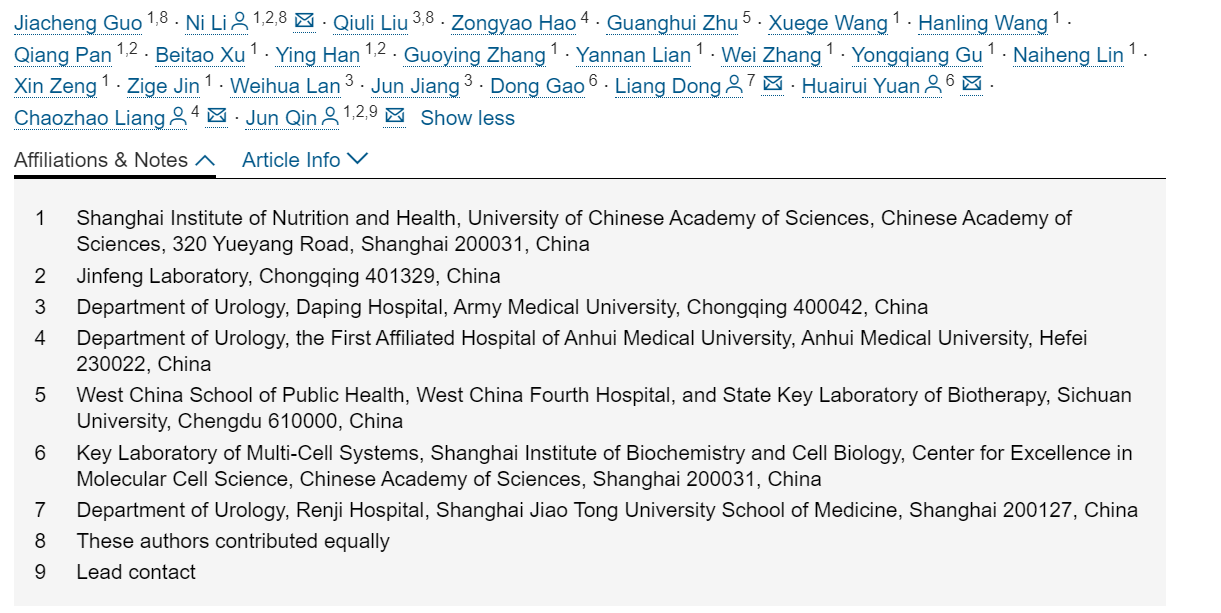
中国科学院上海营养与健康研究所
Summary
Double-negative prostate cancer (DNPC), characterized by an androgen receptor (AR)- and neuroendocrine-null phenotype, frequently emerges following androgen deprivation therapy (ADT). However, our understanding of the origins and regulatory mechanisms of DNPC remains limited. Here, we discover that tumors with KMT2C mutation or loss are highly susceptible to transitioning into DNPC following ADT. We clarify that DNPC primarily stems from luminal cell transdifferentiation rather than basal cell transformation. Antiandrogen treatment induces KMT2C binding at enhancers of a subset of AR-regulated genes, preserving the adenocarcinoma lineage. KMT2C maintains ASPP2 expression via enhancer-promoter communication post-AR inhibition, while its inactivation reduces ASPP2, triggering ΔNp63-dependent transdifferentiation. This DNPC transition maintains fatty acid (FA) synthesis through ΔNp63-mediated SREBP1c transactivation, fueling DNPC growth via HRAS palmitoylation and MAPK signaling activation. These findings highlight KMT2C as an epigenetic checkpoint against DNPC development and suggest the therapeutic potential of targeting fatty acid synthesis.
双阴性前列腺癌(DNPC)是以雄激素受体(AR)与神经内分泌标志物均缺失为特征的一种前列腺癌亚型,常在接受雄激素剥夺治疗(ADT)后出现,但其细胞起源与调控机制尚不明确。本研究发现:携带KMT2C突变或缺失的肿瘤在ADT后极易向DNPC转化;DNPC主要源于管腔细胞的转分化而非基底细胞转化。机制上,抗雄激素治疗可诱导KMT2C结合于AR调控基因的增强子区域,从而维持腺癌谱系;而KMT2C缺失则会通过破坏增强子-启动子互作降低ASPP2表达,触发ΔNp63依赖性转分化。该DNPC转化过程通过ΔNp63介导的SREBP1c反式激活维持脂肪酸(FA)合成,并通过HRAS棕榈酰化激活MAPK信号通路驱动DNPC生长。本研究不仅发现KMT2C是抑制DNPC发展的表观遗传检查点,还提示靶向脂肪酸合成通路具有治疗潜力。
4.Understanding and reversing mammary tumor-driven reprogramming of myelopoiesis to reduce metastatic spread
乳腺肿瘤诱导骨髓造血重编程的机制解析与逆转策略
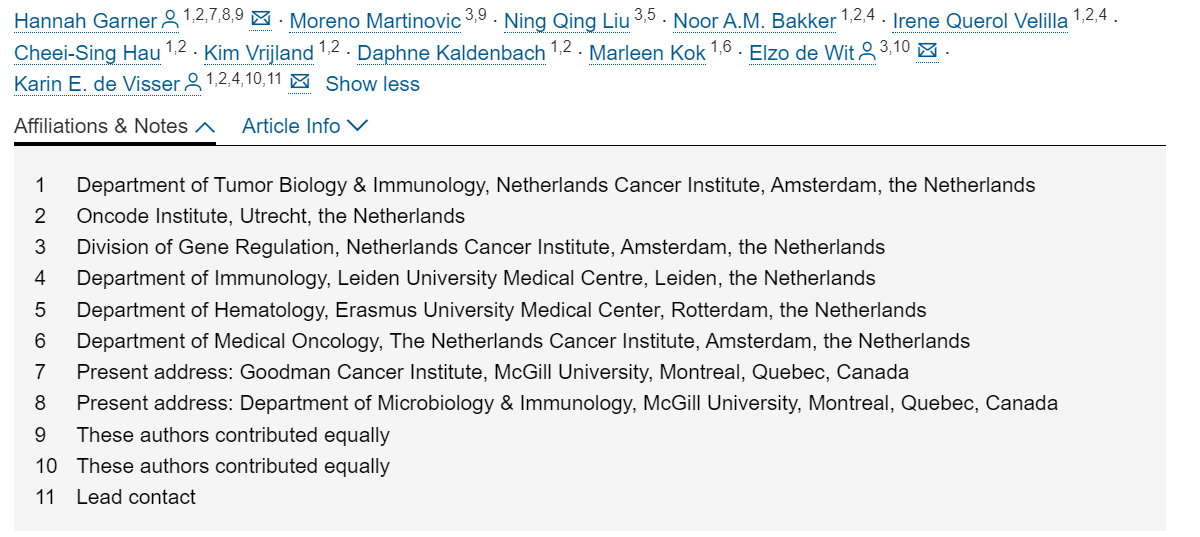
荷兰癌症研究所肿瘤生物学与免疫学系
Summary
Tumor-induced systemic accumulation and polarization of neutrophils to an immunosuppressive phenotype is a potent driver of metastasis formation. Yet, how mammary tumors reprogram granulopoiesis at the molecular level and when tumor imprinting occurs during neutrophil development remains underexplored. Here, we combined single-cell, chromatin and functional analyses to unravel the tumor-driven reprogramming of granulopoiesis in the bone marrow, along with intervention studies aimed at reversing this process. We observe that mammary tumors accelerate commitment to the neutrophil lineage at the expense of lymphopoiesis and erythropoiesis without stimulating the development of a novel myeloid lineage. Moreover, tumor-directed immunosuppressive imprinting of neutrophils starts early in hematopoiesis. Treatment with anti-IL-1β normalizes tumor-induced granulopoiesis, reducing neutrophil immunosuppressive phenotype and mitigating metastatic spread. Together, these data provide molecular insights into the aberrant, tumor-driven neutrophil differentiation pathway leading to metastasis-promoting chronic inflammation and how it can be reversed to reduce metastatic spread.
肿瘤驱动的系统性免疫抑制性中性粒细胞的积累是转移的关键因素,但乳腺肿瘤如何在分子水平重编程粒系造血,以及中性粒细胞发育过程中肿瘤印记的发生时机仍不明确。本研究结合单细胞测序、染色质分析与功能实验,系统解析了骨髓中肿瘤诱导的粒系造血重编程过程,并探索逆转该过程的干预策略。研究发现,乳腺肿瘤在不刺激新髓系谱系产生的前提下,以牺牲淋巴/红细胞生成为代价,加速了中性粒细胞谱系的定向分化进程。此外,肿瘤对中性粒细胞的免疫抑制性印记始于造血早期阶段。使用抗IL-1β治疗可逆转肿瘤诱导的粒系造血异常,降低中性粒细胞免疫抑制表型,从而显著抑制转移扩散。该研究阐明了促转移性慢性炎症背后的异常中性粒细胞分化通路,并揭示通过靶向干预逆转该过程以遏制转移的分子基础。
5.Cisplatin and temozolomide combinatorial treatment triggers hypermutability and immune surveillance in experimental cancer models
顺铂与替莫唑胺联合治疗在实验性癌症模型中触发超突变性与免疫监视
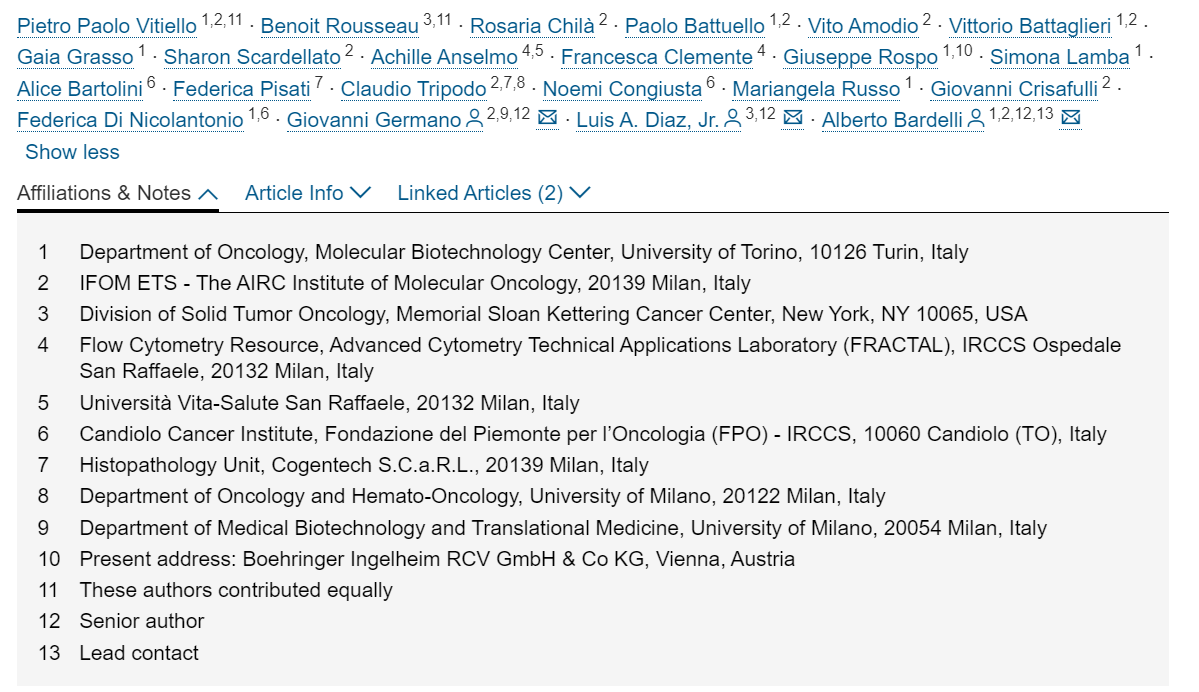
意大利都灵大学分子生物技术中心肿瘤系
Summary
Hypermutation induced by mismatch repair (MMR) inactivation leads to immune surveillance in colorectal cancer (CRC) and in several other malignancies. We investigated the impact of a rationally designed chemotherapy combination on the generation of hypermutation and immunogenicity in otherwise immune-refractory CRC and breast cancer mouse models. Combinatorial treatment with cisplatin (CDDP) and temozolomide (TMZ) induces an adaptive downregulation of MMR, resulting in chemotherapy-dependent hypermutability and increase in predicted neoantigens. This combination specifically alters the immune fitness of the tumors, ultimately leading to CD8+ T cell-mediated immune surveillance, immunoediting of chemotherapy-induced neoantigens, and durable immunological memory. Treatment with CDDP and TMZ also remodels the innate immune microenvironment and induces long-lasting responses and complete rejections when combined with anti-PD-1 therapy in mice. The same effects are not observed using the clinically approved combination of 5-fluorouracil, oxaliplatin, and irinotecan (FOLFOXIRI). Treatment-induced hypermutation can enhance anti-tumor immune responses, offering additional avenues for cancer treatment.
错配修复(MMR)功能失活诱导的超突变可触发结直肠癌及其他恶性肿瘤的免疫监视。本研究通过合理设计的化疗组合方案,探究了其对免疫疗法难治性结直肠癌和乳腺癌小鼠模型产生超突变及免疫原性的影响。顺铂(CDDP)与替莫唑胺(TMZ)的联合治疗可诱导MMR发生适应性下调,从而引发化疗依赖性的超突变水平升高及预测新抗原增加。该联合方案特异性地改变肿瘤的免疫适应性,最终实现CD8+ T细胞介导的免疫监视、化疗诱导新抗原的免疫编辑以及持久免疫记忆的形成。该联合治疗还能重塑先天免疫微环境,当与抗PD-1疗法联用时可在小鼠体内诱导长效应答和完全排斥反应,而临床标准方案5-氟尿嘧啶+奥沙利铂+伊立替康(FOLFOXIRI)并未产生同等效应。治疗诱导的超突变可增强抗肿瘤免疫应答,为癌症治疗开辟了新路径。
6.Induction of a mismatch repair deficient genotype by tailored chemical mutagenesis in experimental models of cancer
在癌症实验模型中通过定制化学诱变诱导错配修复缺陷基因型
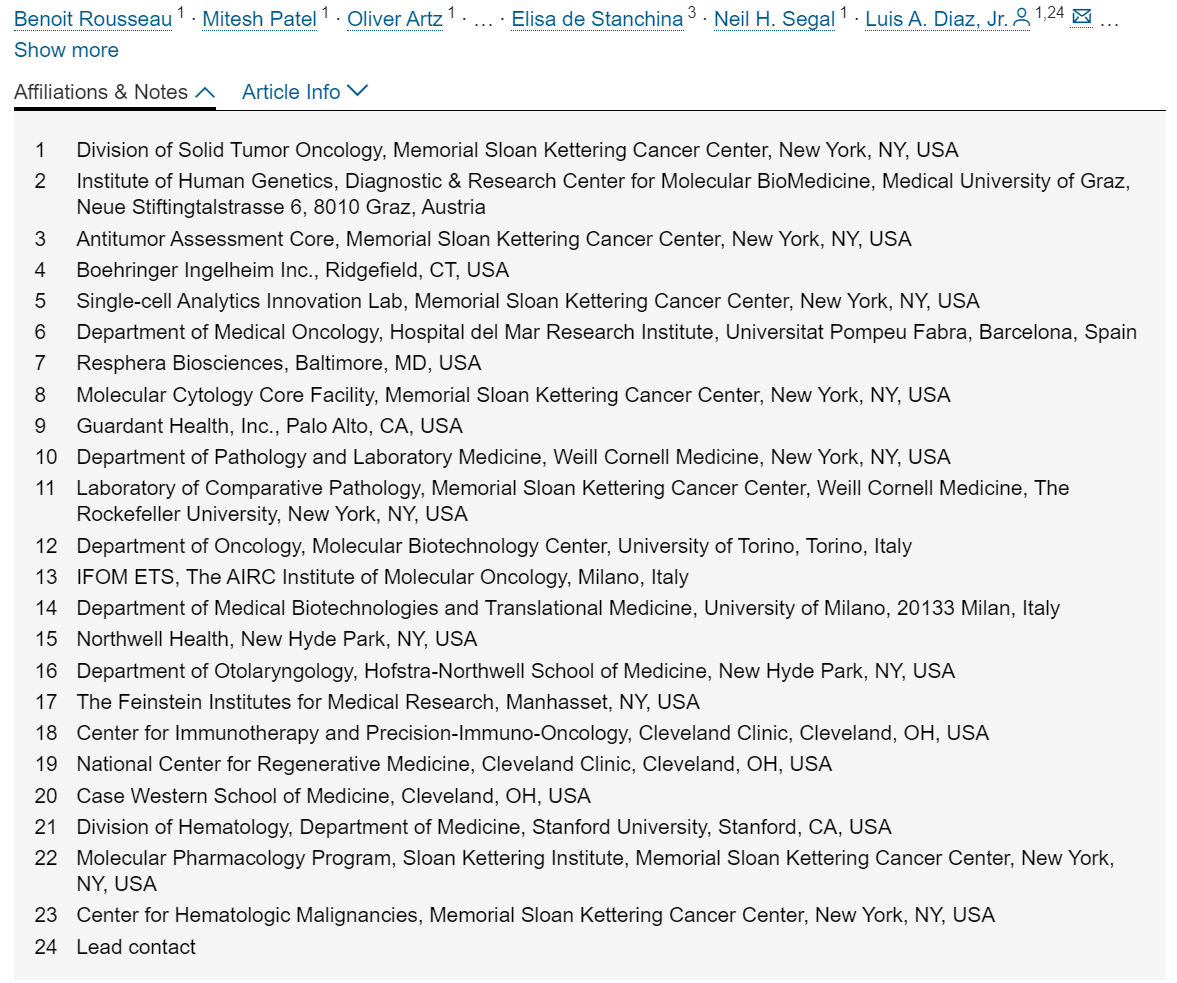
美国纽约纪念斯隆凯特琳癌症中心实体肿瘤肿瘤学部
Summary
Mismatch repair deficient (MMRd) tumors harbor thousands of somatic mutations enriched for insertion–deletion (indels) conferring high sensitivity to immunotherapy. We sought to reproduce this phenotype using mutagenic agents to engineer an MMRd genotype in immunoresistant cells. The combination of temozolomide (TMZ) and cisplatin led to a rapid accumulation of a high mutational load enriched for indels in murine cell lines resulting from the epigenetic loss of Msh2. Pretreated cells showed sensitivity to PD-1 blockade. Systemic treatment with TMZ, cisplatin, and anti-PD-1 bearing immunoresistant tumor cells led to increased survival, intratumoral T cell infiltration, and downregulation of Msh2 expression without affecting healthy tissues. In a clinical trial with 18 patients with refractory mismatch repair proficient colorectal cancer, no responses were seen, but MMRd signatures emerged in cell-free DNA. These findings show that recapitulating an MMRd genotype through chemical mutagenesis can generate an immunogenic phenotype.
错配修复缺陷(MMRd)肿瘤通常携带数千个以插入-缺失突变(indels)为主的体细胞突变,因此对免疫治疗高度敏感。本研究尝试利用诱变剂在免疫抵抗细胞中构建MMRd基因型,以复现该免疫敏感表型。结果显示,替莫唑胺(TMZ)与顺铂联用导致小鼠细胞系发生Msh2表观遗传缺失,并在小鼠细胞系中快速积累高突变负荷(以indels富集为特征)。经预处理的细胞显示出对抗PD-1疗法的敏感性。采用TMZ、顺铂联合抗PD-1疗法治疗携带免疫抵抗肿瘤的小鼠,可显著延长生存期、增加肿瘤内T细胞浸润、下调Msh2表达且不影响健康组织。在一项纳入18例错配修复功能完整型难治性结直肠癌患者的临床试验中,虽未观察到客观缓解,但在游离DNA中检测到了MMRd特征信号。这些结果表明,通过化学诱变复现MMRd基因型可成功构建免疫原性表型。
7.The pan-cancer proteome atlas, a mass spectrometry-based landscape for discovering tumor biology, biomarkers, and therapeutic targets
泛癌蛋白质组图谱:基于质谱技术的肿瘤生物学、生物标志物及治疗靶点发现平台

荷兰阿姆斯特丹大学医学中心(阿姆斯特丹自由大学院区)
Summary
Most cancer proteomics studies to date have focused on a single cancer type. We report The Pan-Cancer Proteome Atlas (TPCPA) based on data-independent acquisition mass spectrometry, to better understand cancer biology and identify therapeutic targets and biomarkers. TPCPA includes 9,670 proteins derived from 999 primary tumors representing 22 cancer types. We describe pan-cancer and cancer type-enriched proteins with extensive external annotation, prioritizing candidate drug targets and biomarkers. Relevant for proteolysis-targeting chimeras, we identify E3-ubiquitin ligases highly expressed in specific tumor types, including HERC5 (esophageal cancer) and RNF5 (liver cancer). Co-expression analysis reveals 13 modules, including unexpected hub proteins as potential drug targets (e.g., GFPT1, LRPPRC, PINK1, DOCK2, and PTPN6). Analysis of 195 colorectal cancers identifies protein markers for RNA-based consensus molecular subtypes (CMSs) and two immune subtypes with prognostic value. We report a cancer type classifier for identification of cancers of unknown primary origin. All TPCPA data can be queried in a dedicated web resource.
当前多数癌症蛋白质组研究聚焦于单一癌种。本研究基于数据非依赖性采集质谱技术构建了泛癌蛋白质组图谱(TPCPA),旨在深入解析癌症生物学,并识别潜在的治疗靶点与生物标志物。TPCPA涵盖22种癌症类型的999例原发肿瘤样本,共鉴定9,670种蛋白质。该研究系统描绘了泛癌共享的及癌种特异性富集的蛋白质,通过广泛外部注释优先筛选候选药物靶点和生物标志物。在蛋白降解靶向嵌合体(PROTAC)相关分析中,鉴定出在特定肿瘤中高表达的E3泛素连接酶(如食管癌中的HERC5、肝癌中的RNF5)。研究通过共表达分析揭示了13个功能模块,其中意外发现的枢纽蛋白可作为潜在药物靶点(如GFPT1、LRPPRC、PINK1、DOCK2和PTPN6)。研究进一步针对195例结直肠癌进行分析,确立了与RNA的共识分子亚型(CMS)相对应的蛋白质标志物,并鉴定出两种具有预后价值的免疫亚型。此外,本研究图谱还开发了癌种分类器,可用于原发灶不明癌症的溯源。所有TPCPA数据均可通过专属网络平台公开查询。
8.Large B cell lymphoma microenvironment archetype profiles
大B细胞淋巴瘤微环境特征模式

美国德克萨斯州休斯敦市德克萨斯大学 MD 安德森癌症中心淋巴瘤和骨髓瘤科
Summary
Large B cell lymphomas (LBCL) are clinically and biologically heterogeneous lymphoid malignancies with complex microenvironments that are central to disease etiology. Here, we have employed single-nucleus multiome profiling of 232 tumor and control biopsies to characterize diverse cell types and subsets that are present in LBCL tumors, effectively capturing the lymphoid, myeloid, and non-hematopoietic cell compartments. Cell subsets co-occurred in stereotypical lymphoma microenvironment archetype profiles (LymphoMAPs) defined by; (1) a sparsity of T cells and high frequencies of cancer-associated fibroblasts and tumor-associated macrophages (FMAC); (2) lymph node architectural cell types with naive and memory T cells (LN); or (3) activated macrophages and exhausted CD8+ T cells (TEX). Divergent patterns of cell-cell communication underpinned the transcriptional phenotypes of archetype-defining cell subsets resulting in exclusion, support, or suppression of T cells, respectively. Consistent with this, LymphoMAPs were associated with significantly different clinical outcomes following CD19 chimeric antigen receptor (CAR) T cell therapy.
大B细胞淋巴瘤(LBCL)是一种临床和生物学上高度异质的淋巴系统恶性肿瘤,其复杂的肿瘤微环境对疾病的发生至关重要。本研究对232份肿瘤及正常对照样本进行单细胞核多组学测序,全面描绘了LBCL肿瘤微环境内包含的各种细胞类型(如免疫细胞和非免疫细胞)。研究结果显示,这些细胞并非随机分布,而是倾向于形成几种具有标志性特征的微环境组合模式 (LymphoMAPs) 。具体包括:(1) T细胞稀少型(FMAC):以癌相关成纤维细胞和肿瘤相关巨噬细胞为主;(2) 淋巴结结构型(LN):包含淋巴结结构细胞并伴随初始和记忆T细胞;(3) T细胞耗竭型(TEX):以活化巨噬细胞和功能衰退的CD8+ T细胞为主。这些不同的LymphoMAPs内部存在差异显著的细胞间通讯网络,分别导致了T细胞排斥、支持或功能抑制,从而塑造了各自独特的微环境状态。临床相关性分析显示,患者在接受CD19 CAR-T细胞免疫治疗后,其治疗效果(预后好坏)与LymphoMAPs的类型存在显著关联。

汇报人:冯兰
导师:任建君、赵宇
审核:夏晓旭、伍施宇



